A) amount by which the quantity supplied of a good exceeds the quantity demanded of a good.
B) measure of consumes' willingness to buy a good plus the price of the good.
C) measure of how much consumers value a good.
D) amount consumers are willing to pay for a good minus the amount the consumers actually pays for it.
Correct Answer

verified
Correct Answer
verified
True/False
Deadweight loss results from too few or too many resources used in a given market.
Correct Answer

verified
Correct Answer
verified
Multiple Choice
Exhibit 3A-2 Comparison of Market Efficiency and Deadweight Loss 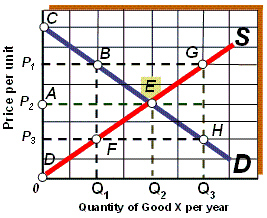 As shown in Exhibit 3A-2, if the market is in equilibrium, then ____ represents producer surplus.
As shown in Exhibit 3A-2, if the market is in equilibrium, then ____ represents producer surplus.
A) FEH
B) EGH
C) DFEA
Correct Answer

verified
Correct Answer
verified
True/False
Total producer surplus is measured by the total area under the equilibrium price and below the supply curve.
Correct Answer

verified
Correct Answer
verified
Multiple Choice
Deadweight loss results from:
A) equilibrium.
B) underproduction.
C) overproduction.
D) none of the above are correct.
E) Either b or c.
Correct Answer

verified
Correct Answer
verified
Multiple Choice
Exhibit 3A-2 Comparison of Market Efficiency and Deadweight Loss 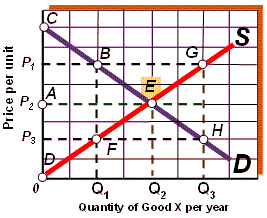 As shown in Exhibit 3A-2, if the market price falls from P2 to P3, then:
As shown in Exhibit 3A-2, if the market price falls from P2 to P3, then:
A) consumer surplus increases.
B) producer surplus increases.
C) deadweight loss increases.
D) all of the above are true.
E) none of the above are true.
Correct Answer

verified
Correct Answer
verified
True/False
Deadweight loss results from a misallocation of resources.
Correct Answer

verified
Correct Answer
verified
True/False
At the equilibrium price, deadweight loss is minimized.
Correct Answer

verified
Correct Answer
verified
Multiple Choice
In an efficient market, deadweight loss is ____.
A) maximum.
B) minimum.
C) constant.
D) zero.
Correct Answer

verified
Correct Answer
verified
Multiple Choice
Exhibit 3A-1 Comparison of Market Efficiency and Deadweight Loss 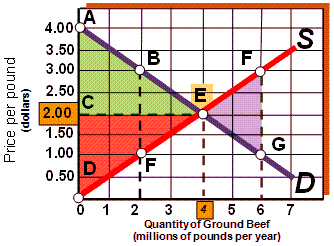 As shown in Exhibit 3A-1, if the market price falls from $2.00 to $1.00, then:
As shown in Exhibit 3A-1, if the market price falls from $2.00 to $1.00, then:
A) total surplus increases.
B) deadweight loss increases.
C) overproduction decreases.
D) underproduction decreases.
Correct Answer

verified
Correct Answer
verified
True/False
Producer surplus measures the value between the actual selling price and the profit-maximization price.
Correct Answer

verified
Correct Answer
verified
Multiple Choice
Exhibit 3A-2 Comparison of Market Efficiency and Deadweight Loss 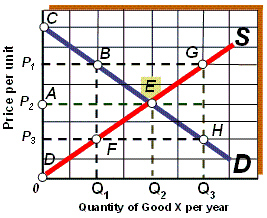 As shown in Exhibit 3A-2, if the market price falls from P2 to P3, then:
As shown in Exhibit 3A-2, if the market price falls from P2 to P3, then:
A) total surplus increases.
B) deadweight loss decreases.
C) overproduction increases.
D) underproduction decreases.
Correct Answer

verified
Correct Answer
verified
Multiple Choice
Consumer surplus:
A) does not exist in equilibrium.
B) is illustrated by the area under the demand curve and above the market price.
C) is illustrated by the area under the demand curve and below the market price.
D) is illustrated by the area above the supply curve and under the demand curve.
Correct Answer

verified
Correct Answer
verified
Multiple Choice
If Bill is willing to pay $10 for one good X, $8 for a second, and $6 for a third, and the market price is $5, then Max's consumer surplus is:
A) $24.
B) $18.
C) $9.
D) $6.
Correct Answer

verified
Correct Answer
verified
Multiple Choice
Suppose a consumer is willing to pay $20 for one good X, $10 for a second, and $5 for a third, and the market price is $4. The consumer surplus is:
A) $16.
B) $6.
C) $1.
D) $23.
Correct Answer

verified
Correct Answer
verified
Multiple Choice
Deadweight loss is the net loss of:
A) consumer surplus.
B) producer surplus.
C) disequilibrium surplus.
D) both a and b.
Correct Answer

verified
Correct Answer
verified
Multiple Choice
Consumer surplus is the:
A) number of consumers who are excluded from a market because of scarcity.
B) amount of a good that consumers will buy at a price below the equilibrium price.
C) amount consumers are willing to pay for a good minus the amount the consumers actually pay for it.
D) amount consumers are willing to pay for a good minus the cost of producing the good.
Correct Answer

verified
Correct Answer
verified
Multiple Choice
Exhibit 3A-2 Comparison of Market Efficiency and Deadweight Loss 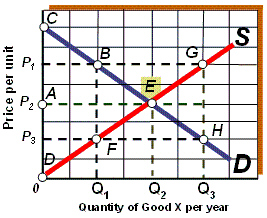 As shown in Exhibit 3A-2, if the quantity supplied of good X per year is Q1, the result is:
As shown in Exhibit 3A-2, if the quantity supplied of good X per year is Q1, the result is:
A) deadweight loss.
B) inefficiency.
C) underproduction.
D) all of the above are true.
E) none of the above are true.
Correct Answer

verified
Correct Answer
verified
Multiple Choice
A drought destroys much of the grape crop. As a result, consumer surplus in the market for wine:
A) decreases.
B) increases.
C) remains unchanged.
D) depends on the deadweight loss.
Correct Answer

verified
Correct Answer
verified
Multiple Choice
Exhibit 3A-1 Comparison of Market Efficiency and Deadweight Loss 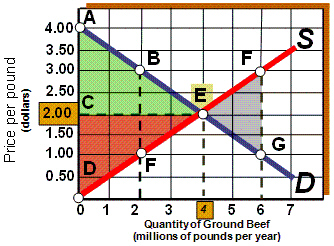 As shown in Exhibit 3A-1, if the market price falls from $3.00 to $2.00, then area ____ disappears.
As shown in Exhibit 3A-1, if the market price falls from $3.00 to $2.00, then area ____ disappears.
A) ABEFD
B) ABEC
C) CEFD
D) BEF
Correct Answer

verified
Correct Answer
verified
Showing 21 - 40 of 68
Related Exams